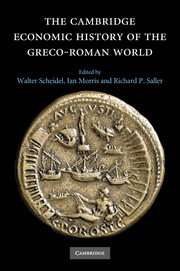Book contents
- Frontmatter
- 1 Introduction
- Part I Determinants of Economic Performance
- Part II Early Mediterranean Economies and the Near East
- Part III Classical Greece
- Part IV The Hellenistic States
- Part V Early Italy and the Roman Republic
- Part VI The Early Roman Empire
- Part VII Regional Development in the Roman Empire
- 24 The Western Provinces
- 25 The Eastern Mediterranean
- 26 Roman Egypt
- 27 The Frontier Zones
- Part VIII Epilogue
- Bibliography
- Index
- Map 1.1 The Mediterranean basin"
- Map 10.1 Greek and Phoenician trade in the period of the Persian Wars"
- Map 11.1 The Achaemenid empire"
- Map 12.1 Greece and Asia Minor"
- Map 15.1 The Seleucid empire"
- Map 16.1 Greco-Roman Egypt"
- Map 20.1 The Roman empire at the accession of Vespasian"
- References
26 - Roman Egypt
from Part VII - Regional Development in the Roman Empire
Published online by Cambridge University Press: 28 March 2008
- Frontmatter
- 1 Introduction
- Part I Determinants of Economic Performance
- Part II Early Mediterranean Economies and the Near East
- Part III Classical Greece
- Part IV The Hellenistic States
- Part V Early Italy and the Roman Republic
- Part VI The Early Roman Empire
- Part VII Regional Development in the Roman Empire
- 24 The Western Provinces
- 25 The Eastern Mediterranean
- 26 Roman Egypt
- 27 The Frontier Zones
- Part VIII Epilogue
- Bibliography
- Index
- Map 1.1 The Mediterranean basin"
- Map 10.1 Greek and Phoenician trade in the period of the Persian Wars"
- Map 11.1 The Achaemenid empire"
- Map 12.1 Greece and Asia Minor"
- Map 15.1 The Seleucid empire"
- Map 16.1 Greco-Roman Egypt"
- Map 20.1 The Roman empire at the accession of Vespasian"
- References
Summary
introduction
This chapter aims to assess the extent, nature, and causes of economic change in Egypt in the first three centuries of Roman rule (30 bc – ad 284). I will argue for significant aggregate and per capita growth in the first two centuries, attributable to the institutional, commercial, and behavioral impact of integration into the Roman world; then, following the Antonine plague, some aggregate decline in production but renewed, if more differentiated, per capita growth attributable to internal socioeconomic changes. The issues of continuity and peculiarity are fundamental. First, in any period we face the myth of the unchanging nature of Egyptian agriculture and agrarian culture, which hinders recognition of times of significant change. Second, Egypt has long been seen as an untypical province of the Roman empire: politically separate, geophysically distinct, culturally unique. So too, supposedly, it was kept outside the general economic structure of the empire, and is untypical for Roman economic history. Few historians now overtly subscribe to this view, but a sub-theme of this chapter is that Egypt is instead our best documented case of the normal regional variation within the empirewide framework.
These problems envelop the papyrological evidence. The 20,000 or so Roman-period texts on papyrus published to date offer a quantity and range of documentary evidence unique in the Roman empire, and permit some quantification of social and economic phenomena. However, the relative wealth is poor and unevenly distributed. Over three centuries we have an average of twenty-one census returns per 14-yearly census, and one price of wine, the best attested commodity, for every two years.
- Type
- Chapter
- Information
- The Cambridge Economic History of the Greco-Roman World , pp. 698 - 719Publisher: Cambridge University PressPrint publication year: 2007
References
- 39
- Cited by



